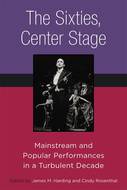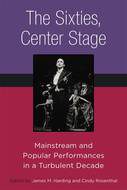Book Review: The Sixties, Center Stage: Mainstream and Popular Performances in a Turbulent Decade
 The Sixties, Center Stage: Mainstream and Popular Performances in a Turbulent Decade.
The Sixties, Center Stage: Mainstream and Popular Performances in a Turbulent Decade.
Edited by James M. Harding and Cindy Rosenthal.
Ann Arbor, MI: University of Michigan Press, 2017.
ISBN 978-0472053360.
For those of a certain age, or even younger, “The Sixties,” writ large, is an era of extraordinary cultural change, indelible in its historic events, art, and politics, filled with iconic moments and revolutionary fervor. Editors James M. Harding and Cindy Rosenthal have enlisted a group of fifteen leading American theatre scholars (including themselves) to unpack the ways in which mainstream popular performances of that time looked at its complexities, contradictions, and extremes, revealing, among many other things, generational friction and artistic changes, some of lasting significance.
What is especially welcome in this collection is its attempt to reveal “The Sixties” less through the overtly provocative radical experimentation of the period, but instead in Broadway and popular theatres, companies, and artists already functioning at the moment the social upheavals began. To those alive in that era, “The Sixties” truly began in the wake of President John F. Kennedy’s assassination and ended sometime around President Richard M. Nixon’s resignation in the midst of the Watergate scandal. The essays here reflect that near decade-long fissure in American life, with an emphasis on the changes wrought on stages. Some of the scholars included look back as far as the 1950s to find the roots of “The Sixties” there, examining musicals (Hair, Oh! Calcutta, Cabaret, Fiddler on the Roof), visiting European productions and influences, breakthrough dramas (Lorraine Hansberry’s A Raisin in the Sun, for example), and innovative acting, design, and staging techniques borne out of the cultural exchanges of European and American theatres, with an emphasis on new voices such as Edward Albee and feminist writers.
Such a compendium as this has the strengths and weaknesses typically resulting from a collection of diverse scholars, the main problem being important developments and performances that do not make the cut. I wondered about the absence of one of the signal American artists the second half of the 20th century, Stephen Sondheim (a single passing reference is made to A Funny Thing Happened on the Way to the Forum [1962]), whose Anyone Can Whistle (1964), Company (1969) and Follies (1971) brought a new seriousness to musicals, while also reflecting the changing mores and the collisions of pre- and post-Sixties values and theatrical techniques. His career seems perfectly situated between the popular stage and the “cutting edge” innovations of the time. However, what is included presents an admirably varied sampling of notable developments and works in five sections effectively framing the essays: “Re-visioning Broadway,” “Theatre Artists’ Transformations and Innovations,” “The European Effect,” “The Rise of Regional Theatres,” and “Popular Demonstrations and Innovative Performances.” These sub-headings identify the contents of each section fairly obviously, shaped by an introduction by the editors that breaks down the artificial boundaries of the established stage with new ideas, as well as a useful afterword by Harding providing closure.
This reader found the sections on Broadway and Regional Theatres of greatest interest. Regarding Broadway, most accounts of 1960s Broadway theatre find in steep decline, but here the contributors point to some enduring achievements in this period of deep economic slump. The section on regional theatres contributes a fuller understanding of the evolution of this phenomenon than is typical, illuminating a major aspect of the 1960s (and beyond) American stage not yet fully explored. Overall, The Sixties, Center Stage will be a much-appreciated collection for serious students and practitioners hoping to understand an often misunderstood decade.
James Fisher
The University of North Carolina at Greensboro

